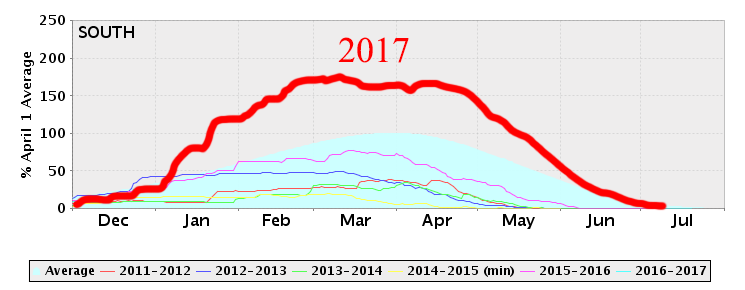Something amazing happened in 2017. Our California winter, which had practically abandoned us the past five years, roared to life. It wasn’t a comeback in the sense that mother nature hit a double and a runner scored, it was more to the effect of she knocked it out of the park and into the neighbors yard. Our snowpack was simply massive.
For the Kern river drainage in particular, the 2017 snowpack trumped the preceding winters of 2012, 2013, 2014, 2015 and 2016 combined. The only data point that loomed larger was the winter of 1983, which for most rafting companies was so long ago that there was scant institutional knowledge of the event and what played out. We were literally in uncharted waters.

This massive snowpack coincided with a local issue, which, to seize the wordplay early, had huge downstream effects. Our dam was (and still is) getting repaired by the Army Corps of Engineers. In 2017 this repair had been going on for years, and effectively meant that there was an artificial cap on how much water could be stored in Lake Isabella. This storage, measured in units called acre-feet, was limited to 361,250 acre-feet; 63% of its normal capacity. In the years prior to the dam repair, the lake could handle a big winter’s runoff. With our limited capacity in 2017 however, it meant that the Army Corps had to keep increasing outflow to avoid cresting the new maximum lake level. This created water levels on the Lower Kern that we had never experienced with the exception of 1983, 34 years prior.
The water was ramped up to 5,400 CFS. With data scarce on what to expect, and our season kick off two months away, we headed out there to see first hand. What we found was amazing: There was so much water and it was so much fun. Every rapid had the volume turned up with each feature exagerrated. Waves were taller, eddies stronger, and the speed was staggering. In average water years we offered a half day trip that would take a few hours to complete. On our 2017 training laps we were zipping through this same section in less than an hour.
We trained every single day, raised our minimum age, cut down on maximum group size and had a successful high water season.
With the big flows and ecstatic guides, a daily discussion topic as common as “hello” and “good morning” greetings came to life: Is this a once-in-a-guiding career moment, similar to 1983? Will we ever get flows like this again?
That season I felt like the answer was no. Those flows were a one-and-done and would never happen again in our careers. History was on my side too, with 1983 being so many years in the past. It didn’t take long for that belief to be shattered however when the 2019 snowpack (not as big as 2017, but still big) again brought Lower Kern flows up to 5,400 for a brief period of time. Once more, the same questions were floated – is this it? Similar to 2017, I felt like the answer was no.

This was not a wide-spread belief though, and to this day plenty of guides, kayakers, private boaters, and community members think that another 5,000+ CFS season is just around the corner. And with the magic of water, the arguments come sprinkled with questionable half-truths and folk-lore which make it a lively debate topic. Listed below:
- From the sting of the drought, downstream water owners have added huge quantites of water storage availability and have increased water efficiency techniques, lessening their need for Lake Isabella water deliveries. This means that Lake Isabella will grow faster compared to previous years, and combined with big winters, will increase the odds of a high water release.
- Climate change is bringing higher variability of epic snowpack swings, from massive snowpacks to bone dry. The big seasons will be so large that high water is all but guaranteed.
- The Army Corps of Engineers, the lead entity on our dam repair project, is far behind schedule, which means the 2017 scenario is more likely to repeat as the project drags on.
I wanted to see if there was validity in these coffee table discussions, so I looked into it myself. If you’ve read Cadillac Desert or have followed water policy, you’re probably under the impression that asking a water question will return an answer buried in obfuscation. Surprisingly, this was not my experience. What I found was that yes, water storage availability has been increased, but not in quantities that would significantly matter. For climate change, definitely the old rule book is out and our winter swings will be sharper, but the question of timing is still far elusive. And the Army Corps. They’re on schedule for the most part. The rumor of multi-year delays are simply that, a rumor.
With that in mind, the best answer I have for the 5,000 CFS question is this: Maybe.




